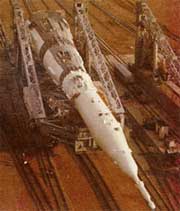Soviet Moon Race
N-1 Launch Vehicle

The Soviet Government Decree of June 23, 1960 "On the
Development of Powerful Launch vehicles, Satellites, Spacecraft,
and Space Exploration in 1960-1967" was enacted to develop the N1
heavy launch vehicle.
The N1 design was to lift a payload of 75 t mass. It was to use liquid-propellant
engines working on oxygen-kerosene on all stages. The launch mass
of the N1 with its payload was 2200 t. Burning of liquid hydrogen
in the capacity of propellant allowed the increase of the payload
to 95 tonnes, permitting the launch of the L3 spacecraft to the
moon.

Work on the N1 was carried out under direct management
of S. P. Korolev , head of the Board of Chief Designers. After his
death in 1966, his first deputy, V. P. Mishin , assumed responsibility
for work on N1-L3. On August 3, 1964 , the Government Decree stated
for the first time that the most important challenge to be met in
space exploration was the use of the N1 to explore the Moon including
an expedition landing to its surface and its subsequent return to
the Earth.
The rocket complex including the N1 and lunar system L3,
intended for landing to the lunar surface and returning a crew of
2 cosmonauts to the Earth (with one crew member landing to the lunar
surface), was designated as N1-L3.
Launch vehicle N1 was made up of three stages (A, B,
V) connected with transfer compartments of a truss type and a core
stage. A structural arrangement included a shell receiving external
loads and accommodating fuel tanks (with an oxidizer tank in the
front part), engines, and other systems in its interior.
The rocket was a package design with suspended, single-unit, spherical
fuel tanks and multi-engine propulsion units on stages I, II, and
III.

The complete N-1, including all five stages, the lunar
module, modified Soyuz with trans-Earth boost stage, and launch escape
system stood 370 ft. (111m) tall.
Its full propellant launch weight was in excessive of 2700 kg.
The N-1 experienced four launch failures due to an
inadequate testing regime of the first stage NK-33 engines. These
engines are still the most efficient LOX-kerosene fuelled engines
developed. NASA technicians inspected these engines in 2004, since
Russia were marketing them to the international launch vehicle market,
and were impressed by their specifications and performance. The Soviet's
hindrance was the difficulty of applying the technological skill
that would control thirty of these engines at launch.
N-1 Stages
1st stage 30 NK-33 LOX/kerosene engines;
10.1 million lb. total thrust.
2 nd stage 8 NK-43 LOX/kerosene engines;
3.1 million lb. total thrust.
3rd stage 4 NK-39 engines; 360,800 lb.
total thrust.
4th stage 1 NK-31 engine; 90,200 lb.
thrust; trans-lunar boost stage.
5th stage 1 engine; 19,200 lb. thrust;
lunar orbit insertion & initial lunar descent stage.















